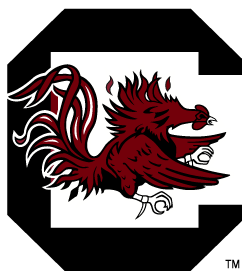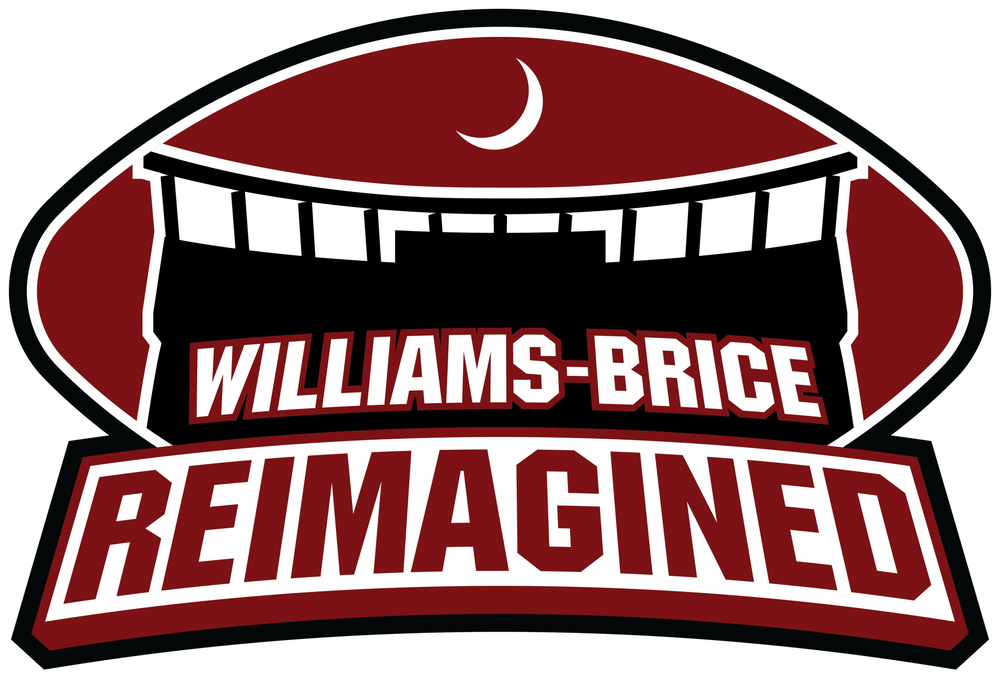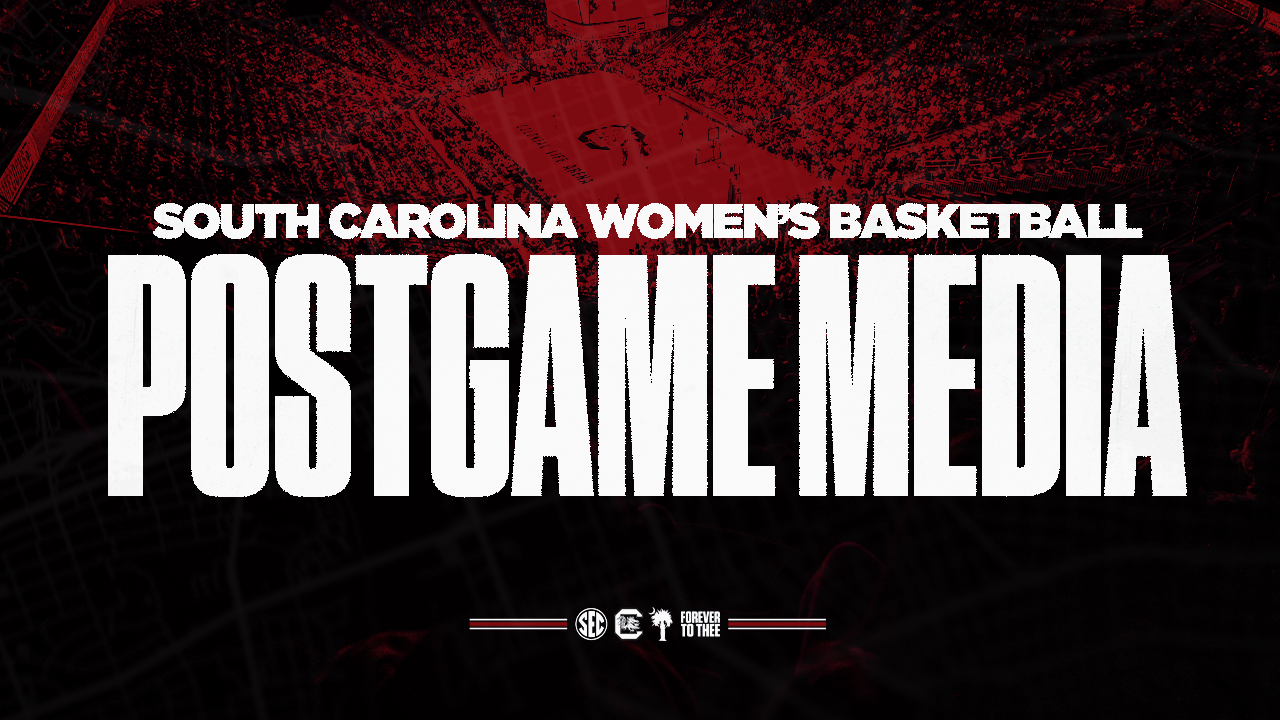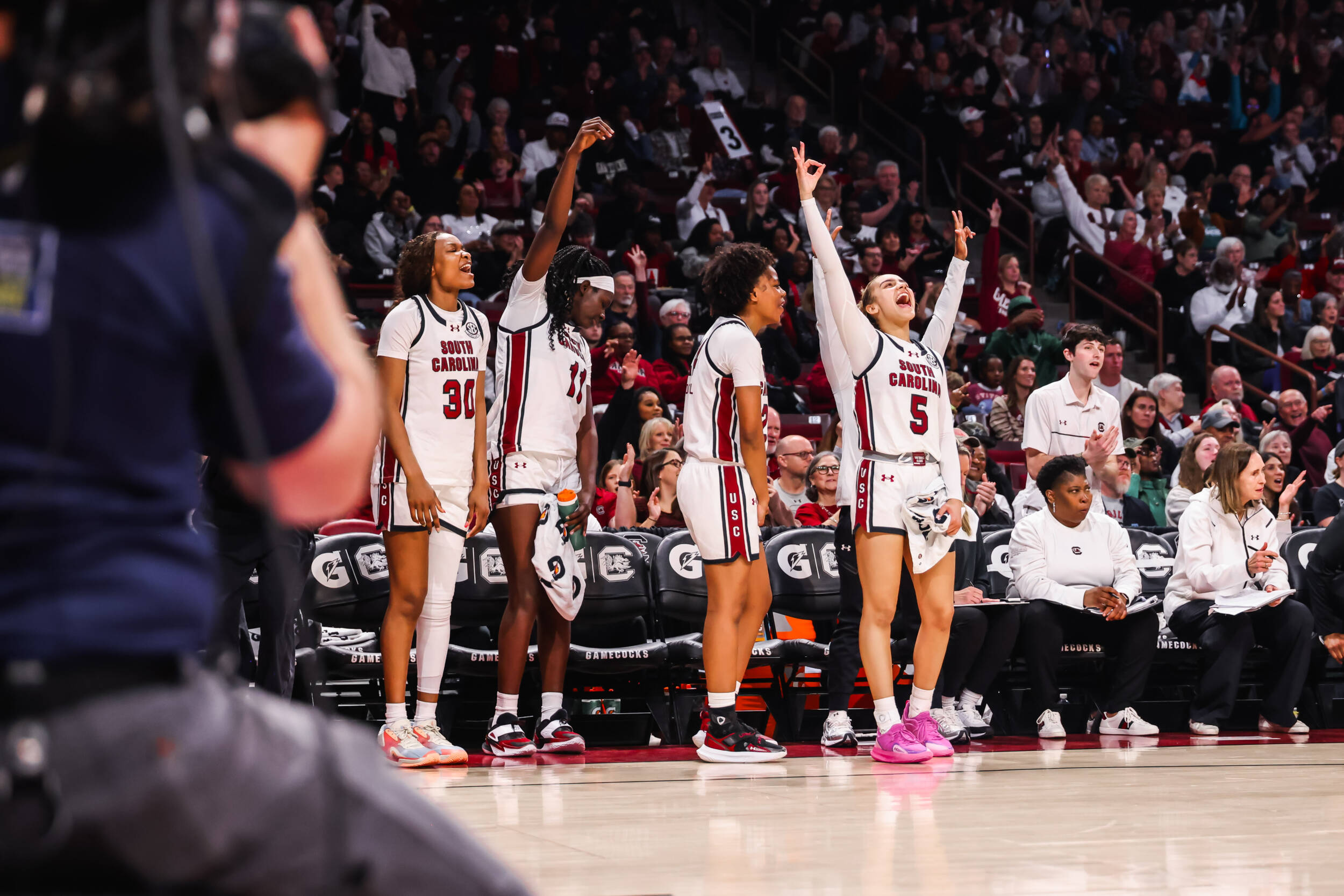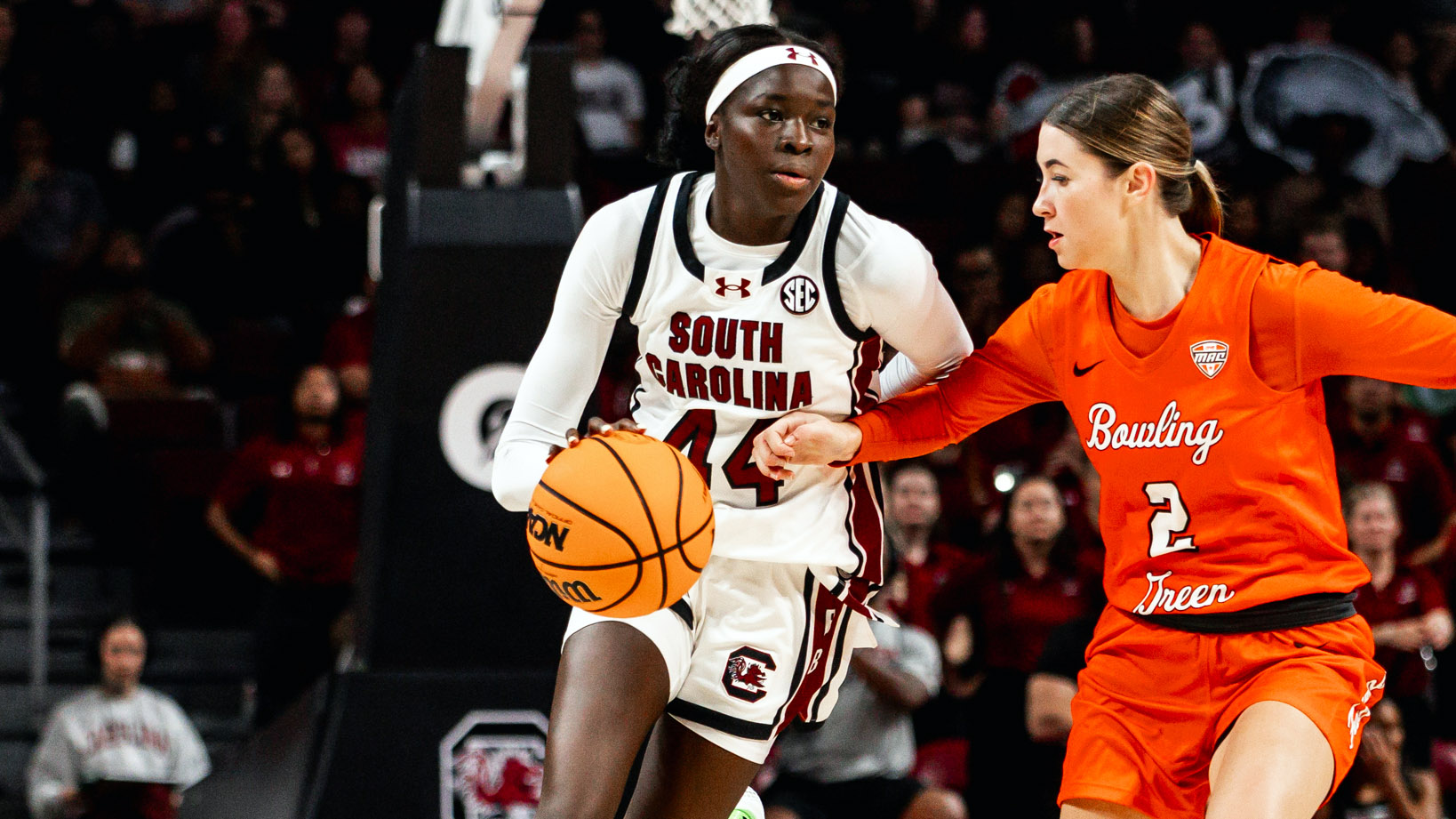Under head coach Susan Walvius, South Carolina has made three trips to the post-season in the last five years, including a Women’s NIT bid in 2005-06. Walvius, who also led the Gamecocks to a pair of top-20 national finishes and NCAA Tournament trips in 2002 and 2003, was at the helm of the program as the Carolina women had the honor of opening the new state-of-the-art Colonial Center on November 22, 2002 with a victory over in-state rival Clemson. USC finished the Colonial Center’s inaugural season with a 14-2 record in the new home for Gamecock basketball. With South Carolina’s recent resurgence similar to the success enjoyed by the Gamecocks in the 1970’s and 1980’s, we pause here to honor the pioneers who blazed the trail for today’s female student-athletes.
There have been many moments of success throughout USC women’s basketball history. The Gamecocks have won 58 percent of all their games, a composite 546-398 record over the past 32 seasons, claimed five Metro Conference regular season championships and three Metro Tournament titles. They have participated in eight NCAA Tournaments, including an Elite Eight appearance in 2002, two Sweet 16 appearances, and captured one Women’s NIT Championship.
In its history, the program has grown from affiliation with the Association of Intercollegiate Athletics for Women (AIAW) to equal membership with all the varsity men’s programs in the National Collegiate Athletic Association (NCAA).
Women’s basketball began competing as a club team in 1967, without a budget or uniforms, facing other college club squads across South Carolina. In 1970, the basketball team (and the volleyball club team) was placed under the Student Affairs Division of the Physical Education department with a small budget. Subsequently, new club teams were added; gymnastics and tennis in 1968; softball in 1971 and swimming in 1972.
In 1973, the women’s basketball club team appeared in the Carolina Coliseum for the first time with two games scheduled as preliminaries to men’s games. The doubleheader games were a big success with the fans and the USC team was so competitive that the USC Athletics Department took the women’s club team under its wing.
Starting in January of 1974, the self-appointed “Carolina Chicks” became a varsity sport at South Carolina with a newly created position, Associate Director of Athletics for Women to lead the way. The woman selected to head up this new division of women’s athletics was Helen Timmermans, a professor in USC’s School of Health and Physical Education.
In addition to her administrative role, Timmermans also served as the University’s gymnastics coach for the first six seasons of that program’s existence. The new Women’s Athletics Director had a budget of $41,000 to spend on her seven varsity sports (basketball, golf, gymnastics, softball, swimming, tennis and volleyball).
When looking for the school’s first basketball coach, Timmermans didn’t need to search too long as she named the highly successful club coach, Pam Backhaus, for the inaugural position. A member of the Kansas State women’s varsity team during her college years, Backhaus was a member of the USC faculty in addition to her coaching duties. Peggy Harden, who had played at South Carolina in the previous four years, assisted Backhaus.
In January 1974, the Carolina Chicks took to the court as official members of the USC Athletics Department. The team finished its inaugural season as State Champions with a 15-7 mark and advanced into the AIAW Regional Playoffs before being eliminated. The season ended there for the first South Carolina team but the fire for women’s basketball at the university was just ignited.
During South Carolina’s 1974-75 season, the team continued its winning ways under Head Coach Pam Backhaus with a 18-12 mark, a fourth-place finish in the state tournament and advancing into the AIAW Regional Playoffs. The women’s program also enjoyed a boost in the yearly budget up to $69,000 but lost golf as one of its seven varsity teams.
One of the biggest achievements for the women’s athletic program in the 1974-75 season was the designation of the first woman athletic trainer in the state of South Carolina. Cheryl Hitchings, who was working on her master’s degree at USC, was named as the athletic trainer for all of the women’s teams.
The USC basketball team weathered a few changes in 1975-76. Frankie Porter came on board as the new head coach, and more importantly, the first scholarships for female student-athletes were awarded during the 1975-76 academic year.
Three women’s basketball players were among the 18 women who received scholarship aid for their athletic achievements; Charlene DuBose, Denise Nanney and Martha Suber.
In 1977, Helen Timmermans resigned and Pam Parsons took over the position as the Women’s Athletics Director. Under her guidance, the Carolina Chicks would continue their success on the court and changed their nickname to the Lady Gamecocks.
In the 1970’s, the USC basketball program was led by Katrina Anderson, Denise Nanney, Charlene DuBose, Joyce Gilbert, Maureen McCauley and Martha Suber.
The Gamecocks continued their winning ways throughout the 1970’s as they put together a 96-59 record, advanced to AIAW regional playoffs four consecutive years (1978-81) and won the 1980 regional, defeating Southern California and Northwestern.
After being eliminated from the AIAW Tournament in 1979, South Carolina won the National Women’s Invitational Tournament in Amarillo, Texas with wins over California, Oregon and Drake. The Gamecocks advanced to the Final Four in 1980 before losing to Tennessee in the semifinals and then defeated Louisiana Tech in the consolation game to claim third place.
The Gamecock basketball program advanced from competing as an independent school to membership in the Metro Conference in 1983-84. The team enjoyed eight years as one of the most dominating teams in the eight-team Metro Conference and won 167 games with only 81 defeats. South Carolina captured the Metro Regular Season Championship in 1986, 1988, 1989, 1990 and 1991 and also won the Metro Tournament Championship in 1986, 1988 and 1990. South Carolina advanced to the Metro Tournament finals three other times.
During their tenure in the Metro Conference, the Gamecocks garnered many awards. Three players were named as the Metro Conference’s Player of the Year and Metro Tournament MVP during the 1980’s; Brantley Southers 1985-86, Martha Parker 1987-88 and 1988-89 and Beth Hunt 1989-90. Head Coach Nancy Wilson earned Coach of the Year honors in 1984-85 and in 1990-91 while Martha Parker and Schonna Banner received back-to-back Newcomer of the Year awards in 1985-86 and 1986-87, respectively.
The Gamecocks have had six head coaches during their existence; Pam Backhaus, 1974-75 and 1976-77; Frankie Porter, 1975-76, Pam Parsons, 1977-82, Terry Kelly, 1982-84, Nancy Wilson 1985-1997 and current head coach Susan Walvius who took over on April 28, 1997. Terry Kelly is the only male to have served as a Gamecock head coach.
Nancy Wilson, whose 227-152 record in 13 seasons accounts for USC records in both total wins and longevity, led the team to all of its Metro Conference Championships. Pam Parsons, 101-43, in four plus seasons, had the best winning percentage at .701.
While many Gamecock teams have been ranked in either the Associated Press or ESPN/USA Today Polls, nine South Carolina squads have finished among the nation’s top 25 in season-ending polls. South Carolina’s 1980 AIAW Final Four and WNIT championship team, which compiled a 30-6 record, was ranked fifth in the final poll.
The 2001-2002 Gamecock squad, which advanced into the Elite Eight of the NCAA Tournament, finished its season ranked at number six by the ESPN/USA Today poll.
After defeating Duke on November 25, 2001, the Gamecocks joined the Associated Poll for the first South Carolina national ranking in 11 years. That team went on to earn Carolina’s first top-10 ranking in 20 years.
Since becoming affiliated with the NCAA in 1981-82, the Gamecocks have qualified for the NCAA Tournament eight times, playing in regionals in 1982, 1986, 1988, 1989, 1990,1991, 2002 and 2003. In 2001-2002, the team advanced into the Elite Eight before losing the East Region Final to Duke.
On two other occasions, USC advanced to the Sweet 16 in the NCAA Tournament. In 1982, the number three-seed Gamecocks swept through the Midwest Region before running into the second-seeded Kentucky team in the semifinals on March 13th.
In 1990, the fifth-seeded Gamecocks enjoyed success in the Mideast Region before being eliminated by top-seed Washington in the semifinals.
Carolina’s History Makers
Over the years, 25 USC players have scored more than 1,000 points in their career, which ranks second in the Southeastern Conference. The first member of the exclusive club was Denise Nanney, whose career began in the club team era, 1973, and ended with the 1976-77 season. A pioneer in women’s collegiate basketball, Nanney accumulated 1,577 points and is still 10th on the all-time list. She also had a school record 24 rebounds in one game.
The latest player to top the 1,000 career point plateau was Cristina Ciocan, who finished her career in 2004 with 1,013 points.
A pair of members of the 2001-02 team, Shaunzinski Gortman and Jocelyn Penn also reached the milestone recently. Gortman finished her four-year career as the 13th all-time leading scorer in South Carolina history with 1,331 points. With her 566 rebounds, Gortman is also one of only 16 women’s basketball players at USC to score 1,000+ points and grab 500+ rebounds.
Jocelyn Penn joined the list of greats during her junior year (2001-02) and returned for her senior season in 2002-03 to extend her records. During her senior year, Penn broke South Carolina’s single game scoring record with 51 points against Stetson. The Conyers, Ga., native moved up to fourth place on the list of Gamecock scoring leaders with 1,939 points during her career. Penn also became the SEC and USC’s career leader in steals with 359 during her career.
South Carolina’s all-time leading scorer, and perhaps the greatest player, was Sheila Foster, a 6-1 center who, like Nanney, was from Spartanburg. Foster, who played for Carolina from 1978-82, scored 2,266 points in 134 career games and claimed a school record 1,427 rebounds.
Foster was a second team All-America choice by Women’s Basketball News Service in 1982, a two-time finalist in 1981 and 1982 for the Wade Trophy which is awarded to the nation’s best woman basketball player, and played several years of professional basketball in Europe. Foster still holds the top spots in career scoring, rebounding, games played, games started and minutes played. Her feats on the court for the University of South Carolina may never be broken.
Katrina Anderson was South Carolina’s first women’s basketball All-America player. She played two seasons at Anderson Junior College before enrolling at USC where she won All-America honors in both 1978 and 1979. Anderson, after graduation, served for a time as women’s basketball coach at Lander University.
Beth Hunt, a 6-2 forward from Garden City, had the highest career scoring average ever for the Gamecocks. She first attended the University of Maryland where she was Freshman of the Year in the ACC. She transferred to South Carolina, averaging 19.7 points per game in 1988-89, and 22.7 in 1989-90 but skipped her senior season to play professional basketball in Europe.
The three highest single-season averages are owned by Shannon Johnson, a guard currently starring with the San Antonio Silver Stars in the WNBA. After averaging just 9.6 points per game as a freshman, Johnson steadily improved to 23.5 in 1993-94, 23.9 in 1994-95, and 24.7 in 1995-96. Her 2,230 points are topped only by Sheila Foster’s 2,266 and they are the only Gamecocks to score more than 2,000 career points. Johnson was a second-team College Sports All-America in 1996 and third team by the Associated Press that same season. She was also a finalist for the Wade Trophy in 1996. She played on the gold medal team in the 2004 Athens Olympics and in the 1983 USA Olympic Festival. Johnson scored 30 or more points 17 times during her career.
The school record for most points in a game was broken during the 2002-03 season by Jocelyn Penn who dropped in 51 points on Stetson on January 4, 2003. Only one month earlier, Penn tied the school mark of 50, which was set by Shannon Johnson from 1996. Penn and Johnson own the top six scoring games in Gamecock history.
One of the best all-around athletes to play for South Carolina in the late 1990’s was Annie Lester. Playing just about every position for South Carolina from 1996-2000, Lester often faced much taller opponents in the paint but was still a dominant rebounder in the SEC. A versatile athlete, Lester finished her four-year career at South Carolina in the top 15 in many categories; 12th in scoring (1,488 points), 10th in career rebounds (785) and sixth in steals (215).
Well-known to USC fans, Annie Lester quickly made news in the SEC as she became the first South Carolina player to be named to the All-SEC Freshman Team in 1996. As a sophomore, Lester was named to the All-SEC Second Team after leading USC in scoring, rebounding, steals and free throw percentage. During her third season, she passed the 1,000 point plateau and the 500 rebound mark. As a senior, she helped pave the way on the team for her younger sister, Jocelyn Penn, as they became one of only three sister tandems to play at the same time at USC.
Hall of Fame
In the history of the USC women’s basketball program, only Katrina Anderson, Sheila Foster, Martha Parker and Shannon Johnson have had the honor of having their jersey numbers retired.
Katrina Anderson played only two years at South Carolina, but went down in history as the Gamecocks’ first women’s basketball All-American when she received the honor in 1978-79. Anderson averaged 22.2 points per game in 1977-78 and came back to average 18.9 points per game in 1978-79. She remains the school record holder for points scored in a single season, as she scored 754 in 1977-78. She also holds the single-season school record for free throws attempted, rebounds, rebounding average and steals. Her career average of 20.5 points per game ranks as the second-highest mark in school history.
Anderson scored as many as 41 points in a single game and collected as many as 22 rebounds in a single game. To this day, her single-season marks for minutes played (1,267), points scored (754), scoring average (22.2), field goals made (306), field goals attempted (544), field goal percentage (.563), free throws made (142), free throws attempted (242) rebounds (436), rebounding average (12.8) and steals (126) still rank among the top 10 in school history.
With a still-standing school record of 2,266 points and 1,427 rebounds, Sheila Foster was one of the most dominating players in the history of college basketball. In 1982, Sheila Foster became the first Lady Gamecock to have her jersey number retired and on April 26, 2001, Foster was inducted into the South Carolina Hall of Fame. The native of Spartanburg, South Carolina, is still extremely active with youth basketball in South Carolina and can usually be seen at home games with a group of 75 kids as part of South Carolina’s Hot Shots Club.
Martha Parker garnered numerous awards for both her athletic and academic success. During her four-year career, the Columbia, South Carolina native scored 1,791 points, which ranks fifth on the all-time Gamecock list. Parker was a first team All-America choice by Women’s Basketball News Service in 1989, made the second team in 1988, and was a third team Freshman All-America by the Women’s Basketball News Service in 1986. She was also twice named Metro Conference Player of the Year with a career scoring average of 13.9. Her jersey was retired during halftime of her last home game on March 1, 1989.
Parker was a member of the GTE Academic All American Team in her last two years and was honored with the Baden Post-Graduate Scholarship in 1989. She went on to medical school and now has a family practice along with her husband, Dr. Martin Hester, in Columbia.
Johnson is the only player in South Carolina history to average more than 20 points per game for three consecutive seasons, as she averaged 23.5 ppg as a sophomore in 1993-94, 23.9 ppg as a junior in 1994-95 and a school-record 24.7 ppg as a senior in 1995-96. Her career average of 20.4 points per game is a school record by a wide margin. A three-time all-SEC performer, Johnson earned All-America recognition from the Associated Press in 1995-96 and was a finalist for the Wade Trophy.
In 2004, Johnson was the starting point guard for Team USA as it made an undefeated run to the gold medal at the Athens Olympics.
Evelyn “Sweet E” Johnson, 1979-83, and Sue Shue, 1978, were from prominent basketball families. Evelyn’s brother, “Magic” Johnson was a Michigan State All-America and a superstar in the National Basketball Association. Evelyn Johnson averaged 14.3 points per game for the Lady Gamecocks, ranking eighth all-time with 1,620 career points. Gene Shue, Sue’s father, was head coach at Maryland and with the Baltimore Bullets of the NBA. Her Gamecock career was limited to one season before she transferred to the College of Charleston.
The SEC Era
In 1991, the University of South Carolina joined the Southeastern Conference, the toughest women’s basketball conference in the country. The team struggled in earlier years but under the watch of head coach Susan Walvius, USC began to make waves in the SEC.
During the 2000-01 season, several Gamecocks were honored by the SEC. Columbia native Teresa Geter was named as the SEC Player of the Week on January 8, 2001, for achievements against Arkansas and Auburn in the ninth week of the season. At the time, Geter was only the third player in USC history to win the weekly honor and the last since Annie Lester accomplished the feat on February 2, 2000.
South Carolina placed two players on the All-SEC Second Team with juniors Shaunzinski Gortman and Teresa Geter receiving the honors in 2000-2001. It was the sixth time that a USC player had been named to the SEC’s postseason squad.
During the 2001-2002 season, the Gamecock women’s basketball team made its last year in the Carolina Coliseum a memorable one as the team put together one of the most successful seasons ever in USC basketball history.
The Gamecocks reminded fans of earlier USC women’s basketball teams with a 25-7 record, a national ranking and the first NCAA Tournament appearance in 11 years. USC advanced to the Elite Eight of the NCAA Tournament for the first time in school history and came tantalizingly close to advancing to the Final Four. In the final ESPN-USA today Poll, South Carolina was ranked number six in the country.
In 2001-02, USC compiled an all-time high 17-1 record in the Carolina Coliseum to conclude its 28-year homecourt run with a 216-88 mark and a 71% winning percentage. On January 17, 2002, South Carolina sold out the Carolina Coliseum (12,401 tickets) for the SEC contest against Tennessee. With 12,168 fans in attendance, it was the largest basketball crowd in the Coliseum all year, men or women.
Head coach Susan Walvius earned SEC Coach of the Year honors and was also named as the WBCA/Russell Athletic District 3 Coach of the Year. She was also a finalist for the Naismith College Basketball Coach of the Year award.
Three Gamecocks earned SEC Players of the Week honors (Kelly Morrone, Shaunzinski Gortman and Cristina Ciocan) for a South Carolina first. Gortman and Jocelyn Penn were both first team all-SEC selections, marking the first two-player honor in USC history. Gortman also was named to the honorable mention All America squad. In April of 2002, Gortman was the first SEC player selected in the WNBA Draft as the Charlotte Sting made her the ninth overall pick.
In 2002-03, the Gamecocks enjoyed another stellar season by compiling a 23-8 overall record and finished fifth in the SEC in the team’s first year in the Colonial Center. Opening the season with a thrilling victory over Clemson in front of 17,712 fans, the Gamecocks recorded their second consecutive 20+ win season, a fifth-place finish in the SEC and another invitation to the NCAA Tournament. Rising as high as 12th in the polls, South Carolina ended the season ranked 18th in the ESPN/USA Today Coaches’ Poll and 16th in the AP poll.
For senior Jocelyn Penn, the 2002-03 season was the culmination of her four years of hard work at USC. Setting numerous records during the year, Penn became the SEC and South Carolina all-time career leader in steals (359), scored a school record 51 points in a game against Stetson after earlier contributing 50 versus Wofford.
Penn became one of only four South Carolina women to score 1,500+ points, grab 500+ rebounds and make 200+ steals in a career. She moved up to fourth on the all-time Gamecock scoring list with 1,939 points and 27th in SEC history. For her efforts, Penn was named as the SEC Player of the Week twice, was a unanimous First Team All-SEC selection by the coaches and AP and was also named to the AP All-America Second Team.
Petra Ujhelyi made her mark on the boards in 2002-03 as she led the SEC in rebounding the entire season with 9.3 boards per game. The senior also set a South Carolina record with 198 defensive rebounds during her senior year.
Penn and Ujhelyi were high picks in the 2003 WNBA Draft as the addition of the duo brought South Carolina’s number of women playing professional basketball up to four (Shannon Johnson, Shaun Gortman, Penn and Ujhelyi).
To help celebrate the University’s 200th birthday, we decided to look further into the history of women’s basketball. You know that 1974-75 was the first season for women’s basketball at South Carolina as an athletic department sponsored- sport. And in the 1960’s, there were club teams on campus competing against club teams from other schools. But that doesn’t mean women weren’t playing basketball on the USC campus before this time.
By looking at the Garnet & Black yearbooks displayed in the South Caroliana Library on campus, we found that women’s basketball at USC dates back to at least 1922 when women participated in basketball, playing against each other and against other schools. Called Co-Ed Athletics, these activities didn’t refer to men and women competing in sports together. Co-ed Athletics was the term given to the women’s sports teams at the University of South Carolina and in the 1920’s, women learned how to play tennis, volleyball and basketball.
In 1923, the South Carolina co-ed basketball team began competing against teams from other schools such as Newberry, the College of Charleston, Columbia High School and Anderson. Nicknamed the “Pullets”, the USC co-eds put together a 7-6 record and made a road trip to Charleston, an unheard of feat for young women, to play the College of Charleston.
In 1925, the team again made news as it made two notable departures from the customs of former teams at Carolina. The first change was the wearing of regular basketball uniforms with numerals, similar to those used by the men’s teams. The second change was even more eye-raising as the Pullets were the first women’s team in the state to make out-of state road trips.
The 1925 team compiled a record of 5-7 and made a five-game five-day trip to Virginia to take on the women’s basketball teams at Fredericksburg, Westhampton, Farmville and William & Mary.
In the 1930’s, the women continued playing basketball but instead of playing against other schools, they were divided by their class (freshmen, sophomores, juniors and seniors) for competition. In 1936, the Women’s Athletic Association was organized by the University to encourage athletic competition among women. Comprised of one member of each sorority, dormitory and independent group on campus, the WAA sponsored tournaments for sorority and non-sorority groups as they competed for the Carolina Championship Cup in basketball, tennis and volleyball. These WAA competitions were the beginning of the intramural programs that South Carolina still offers today.
In the 1940’s and 1950’s, the women’s basketball teams were allowed to organize into teams by themselves and after the championships were awarded, the WAA gave public exhibitions in all of the University’s Co-Ed sports of basketball, swimming and volleyball. Several sports such as fencing, rifle, archery, badminton, bowling, softball and horseback riding were also added to the instructional activities list during this decade.
In 1953, the WAA attracted a large membership of women and the Association adopted a “Points System.” Similar to a “letterman’s club,” women were awarded Block C’s and stars for their athletic achievements. The intramural basketball continued into the 1960’s and women began to take their basketball, and participating in sports, more seriously.
